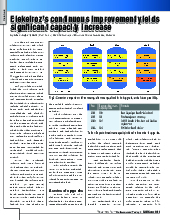Customised Bed Solutions with New Quattro Catalysts Article
Click here for our latest article published in the January-February 2021 issue of Sulphur magazine published by BCInsight.
This section is available in the following languages: English
At BASF, all of that comes with total service dedication, reliable customer support backed by the inventor of sulfuric acid catalysts, and decades of experience.
Click here for our latest article published in the January-February 2021 issue of Sulphur magazine published by BCInsight.
Because BASF designs sulfuric acid catalysts to maximize outcomes, their exceptional stability and large surface area deliver consistent, lasting results. Our customers receive a longer-lasting catalyst with exceptionally low SO2 emissions, energy savings and reduced downtime risks, which translates to improved regulatory compliance, saved costs and more profit. Our knowledgeable specialists deliver all that along with dedicated customer support.
When customers work with BASF, they benefit from our decades of experience in:
In 2022, BASF introduced the novel X3D™ technology, a new additive manufacturing technology for catalysts based on 3D printing. Catalysts produced with this step-change technology feature an open structure resulting in reduction of the pressure drop across the reactor and a high surface area, significantly improving the catalysts’ performance. BASF can apply the technology to a wide variety of existing catalytic materials. BASF’s Sulfuric Acid catalysts O4-111 X3D™ and O4-115 X3D™ are the first catalysts produced with the new technology and already being used in industrial plants. Read more here.
In 1913, the first patent on the vanadium-based catalyst was granted to BASF. Invented by BASF, the vanadium-based catalyst is still the chemical foundation of all sulfuric acid catalysts on the market.
That’s how the new O4-115 Quattro was born. The latest addition to our catalyst family features a 30 percent higher surface area and improved pore accessibility to boost performance, reduce emissions and further increase your plant capacity. This new shape is patented by BASF.
BASF catalysts are proven in our plants and designed to enhance yours. Our sulfuric acid production plants have had the lowest SO2 emissions in the world since 1913, making them ideal for regulatory compliance and cost savings. Work with us to get the full benefit of almost a century’s worth of experience. Our oxidation catalysts are optimized for manufacturers that produce:
For the catalytic oxidation of SO2 in the production of sulfuric acid. Preferably installed in the first bed.
For the catalytic oxidation of SO2 in the production of sulfuric acid. Preferably installed in the second to fifth bed.
For the catalytic oxidation of SO2 in the production of sulfuric acid. Because of its excellent low temperature activity, catalyst O4-115 may be installed as an ignition layer or full bed application
For the catalytic oxidation of SO2 to SO3 for the production of sulfuric acid. Because of its excellent low temperature activity, catalyst O4-116 is installed in the lower passes to improve the…

BASF employees will automatically receive this document when requested
BASF employees will automatically receive this document when requested
BASF employees will automatically receive this document when requested
Complete the form to get in touch with a BASF representative who can help you capitalize on new opportunities in the sulfuric acid catalysts space.
